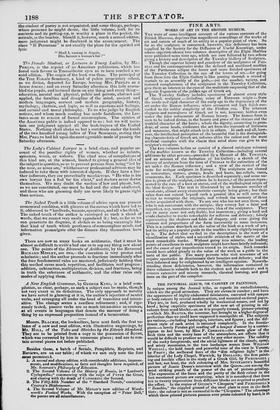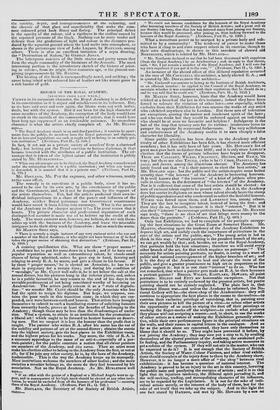THE PICTORIAL ALBUM, OR CABINET OF PAINTINGS,
Is unique among the Annual tribe, as regards its embellishments, which are the grand attraction. They are eleven in number ; and have the appearance of highly-elaborated miniatures, executed with opaque or body colours by several modern artists, and mounted on tinted paper. They are, in fact, produced wholly by mechanical means, and not by hand ; being exquisite specimens of the new art of printing in oil- colours from wood blocks—or, as it is properly termed, picture-printing —which Mr. BAXTER, the inventor, has brought to a higher degree of perfection than we could have supposed it susceptible of. The subjects are various,—including landscapes, interiors, and figures ; and the dif- ferent style of each artist is imitated completely. In the frontis- piece—a lovely Persian girl sending off a bouquet d'amour by a carrier- pigeon to her lover, by Miss F. CORBAUX—the warm glow of the flesh tints and the sunny haze of the atmosphere, are effects that it would be difficult to produce so well by any other means. The solidity of the rocky foregrounds, and the aerial lightness of the clouds, spray, and misty mountains, in the two landscape scenes from WILLIAM WESTALL; the bold touch and powerful tone of the view in Verona, by PROUT; the mellowed hues of the "dim religious light" in the interior of the Lady Chapel, Warwick, by HOLLAND; the firm paint- ing and forcible effect in the study of a Greek Girl, by PICKERSGILL ; and last, not least, the rich colouring of Mrs. SEYETARTH'S beautiful picture of Jeanie Deans's interview with the Queen—are among the most striking proofs of the power of the art of picture-printing. The expression of the faces and the purity of the flesh colour in the last- mentioned picture are surprising, when it is considered that from ten to twenty impressions from different blocks are required to produce the effect. In the copies of GUIDO'S " Cleopatra" and Piceeasent's " Zenobia," the stippled ground of the steel plate is seen in the flesh tints : the colour is not so successful in the "Cleopatra." The advantage which these printed pictures possess over prints coloured by band, is in the solidity, depth, and homogeneousness of the colouring, and the absence of that glare and superficiality that make the com- mon coloured print look flimsy and flaring. The principal defect is the opacity of the colour, and a rigidness in the outline caused by the repeated pressure of the block. Nothing can be more tender and delicate than the gradations of light and colour in the distances pro- duced by the aquatint ground where the land melts into atmosphere, as shown in the picturesque view of Lake Lugano, by BARNARD, among others. There is also an excellent imitation of a sepia drawing, the " Destruction of Sodom," by GEORGE JONES.
The letterpress consists of the little stories and pretty verses that form the staple commodity of the literature of theAnnuals. The most interesting portion is the introductory sketch of the history of print- ing in colours, from its origin, three centuries ago, .:o the present sur- prising improvements by Mr. BAXTER. The binding of the book is correspondingly novel, and striking ; the cover being inlaid with coloured bits of leather set like mimic gems in a rich border of gold.



























 Previous page
Previous page